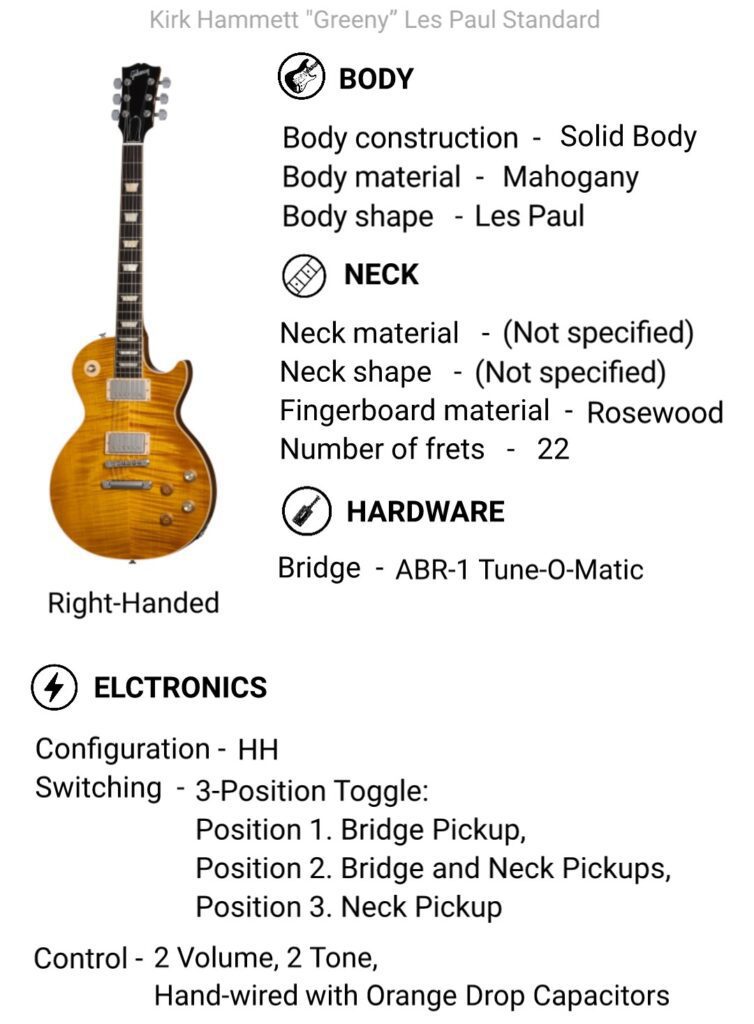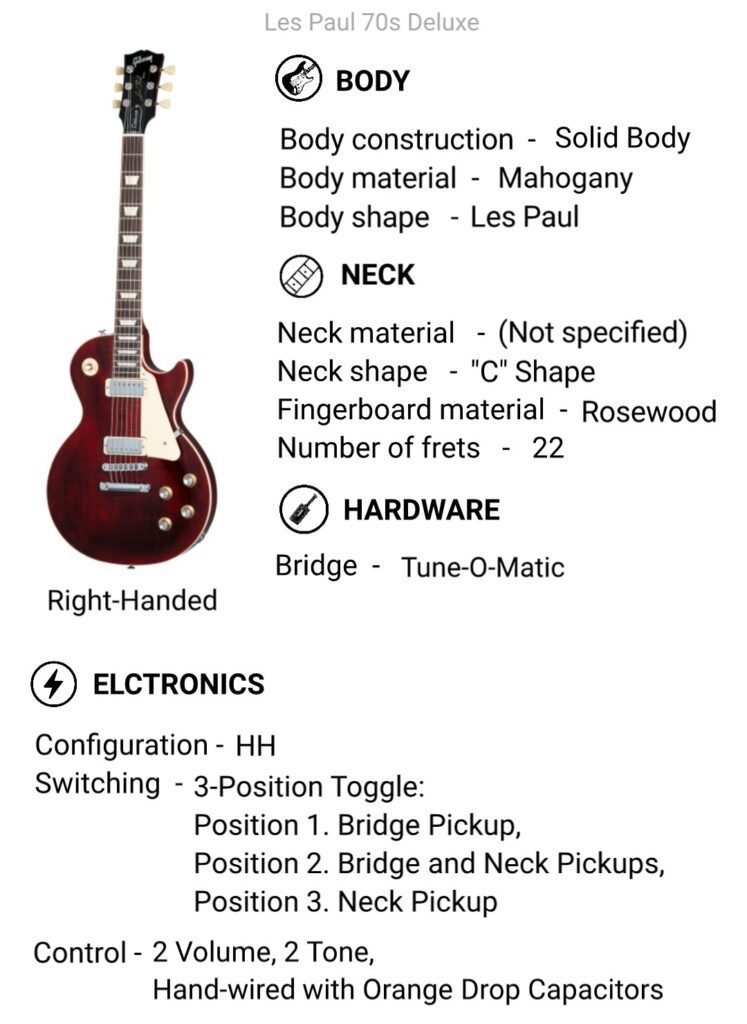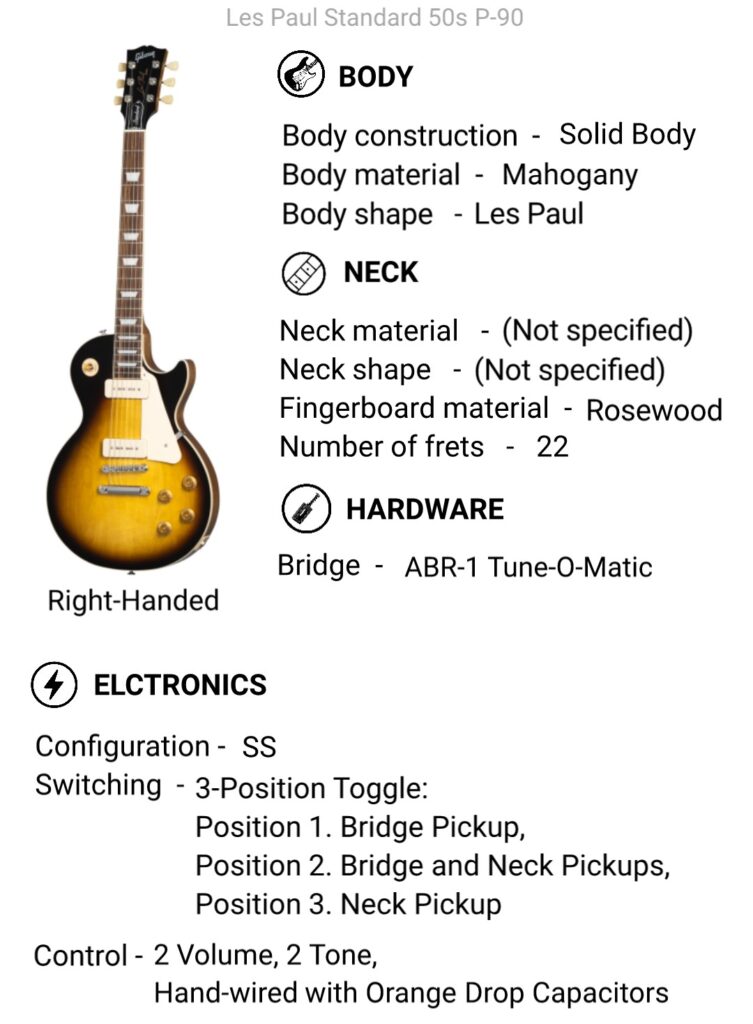list of all Gibson electric guitar with prices, specifications and features from difference online
stores at infinicisum.net
Gibson Kirk Hammett “Greeny” Les Paul Standard

Gibson Les Paul 70s Deluxe

Gibson Les Paul Standard 50s P-90

Introduction: Gibson electric guitars stand as pillars of musical history, shaping the sounds of generations and defining the essence of rock and blues. Since its inception in the early 20th century, Gibson has been synonymous with craftsmanship, innovation, and iconic design. In this comprehensive guide, we delve into the diverse world of Gibson electric guitars, exploring their rich history, key models, and renowned series.
”Read_More”
1. Les Paul Series:
- The Les Paul series is one of Gibson’s most iconic lines, known for its single-cutaway design, mahogany body, and maple top. It includes various models like the Standard, Custom, Studio, Junior, Special, and Modern, each offering distinct features catering to different players and styles.
2. SG Series:
- The SG series features the iconic “double-horn” design, delivering a lighter and more contoured alternative to the Les Paul. Models like the SG Standard, SG Special, SG Junior, and SG Modern are popular for their sharp tones and comfortable playability.
3. ES Series:
- The ES series includes semi-hollow and hollow body guitars, providing a rich, resonant tone. Models like the ES-335, ES-339, ES-175, ES-345, ES-355, and ES-330 are widely used in jazz, blues, and rock.
4. Firebird Series:
- The Firebird series boasts a unique reverse-body design and through-body neck construction. The Firebird and Firebird Studio models offer a distinctive look and a bright, snappy tone.
5. Explorer Series:
- The Explorer series features modern, angular designs, known for their bold appearance and powerful tones. The Explorer and Explorer B-2 models are favored by players in rock and metal genres.
6. Flying V Series:
- The Flying V series is characterized by its V-shaped body, providing a striking visual statement and a focused tone. Models like the Flying V and Flying V B-2 are associated with hard rock and metal.
7. Midtown Series:
- The Midtown series offers a blend of classic and modern design elements. Models like the Midtown Standard and Midtown Custom feature a more compact body design and versatile tonal options.
8. Melody Maker Series:
- The Melody Maker series is known for its simplicity and affordability. Models like the Melody Maker and Melody Maker SG are straightforward guitars with a focus on playability.
9. Modern Series:
- The Modern series represents Gibson’s contemporary approach to electric guitar design. Models like the Gibson Modern Les Paul Standard and Gibson Modern SG Standard incorporate modern features for today’s players.
10. Double-Neck Series:
- The Double-Neck series, exemplified by the EDS-1275 Double Neck, features guitars with two necks, typically one six-string and one twelve-string. These guitars allow players to switch between different tunings or sounds.
11. Acoustic-Electric Guitars:
- Gibson’s acoustic-electric guitars include iconic models like the J-45, Hummingbird, SJ-200, and Dove. These guitars combine Gibson’s acoustic craftsmanship with built-in electronics for amplified performance.
12. Custom Shop Series:
- The Custom Shop series produces high-end, handcrafted guitars. Custom Shop models are often reissues of classic instruments, and they showcase meticulous craftsmanship and attention to detail.
13. Historic Reissues:
- Historic Reissue models recreate classic guitars from Gibson’s past, aiming to capture the essence of vintage instruments. This series includes reissues of Les Pauls, SGs, Explorers, and Firebirds.
14. Artist Signature Models:
- Artist Signature models are guitars developed in collaboration with renowned musicians. Examples include the Slash Les Paul, Joe Bonamassa Les Paul, Eric Clapton 1960 Les Paul, Peter Frampton Les Paul Custom, and Alex Lifeson Les Paul Axcess.
15. Limited Edition Series:
- The Limited Edition series includes guitars with unique features, finishes, or specifications. These models are produced in smaller quantities, making them collector’s items for enthusiasts.
16. Original Collection:
- The Original Collection features guitars like the Les Paul Standard ’50s and ’60s, SG Standard ’61, SG Standard ’61 Maestro Vibrola, and Les Paul Special Tribute DC. These models often pay homage to classic designs with modern enhancements.
Conclusion: Gibson electric guitars have left an indelible mark on the music landscape, defining genres and inspiring countless musicians. Whether it’s the timeless Les Paul, the sleek SG, the versatile ES series, or the handcrafted gems from the Custom Shop, Gibson guitars continue to embody the spirit of innovation and excellence. With a legacy spanning over a century, Gibson remains at the forefront of the guitar world, crafting instruments that resonate with the passion and creativity of players around the globe.
How to choose Right Gibson electric Guitar
Choosing the right Gibson electric guitar involves considering various factors to match your playing style, preferences, and budget. Here’s a guide to help you navigate the process and find the perfect Gibson guitar for you:
1. Define Your Budget:
- Gibson offers a range of electric guitars at different price points. Determine your budget to narrow down your options and focus on guitars within your financial range.
2. Identify Your Playing Style:
- Different Gibson models cater to various playing styles. Consider the genre or genres you primarily play, whether it’s rock, blues, jazz, metal, or a combination. This will influence the type of pickups, body shape, and tonal characteristics you’ll want in your guitar.
3. Choose the Right Body Style:
- Gibson offers guitars with different body styles, including single-cutaway Les Pauls, double-cutaway SGs, and semi-hollow ES models. Each body style has its own sonic characteristics and playability. Consider which design feels comfortable and suits your aesthetic preferences.
4. Pickups and Tonal Characteristics:
- Gibson electric guitars often come with either humbucking or P90 pickups. Humbuckers are known for their warm and powerful sound, while P90s provide a more raw and biting tone. Determine which pickup type aligns with the sound you’re seeking.
5. Consider Neck Profile and Scale Length:
- Gibson guitars come with various neck profiles, such as ’50s, ’60s, and Slim Taper. Neck profiles affect the feel of the guitar in your hands. Additionally, consider the scale length (distance between the bridge and nut) as it can influence playability and string tension.
6. Explore Different Series:
- Gibson offers various series, each with its own features and characteristics. Explore series like the Les Paul Standard, SG Standard, ES, Custom Shop, Modern, and Original Collection. Each series may offer unique design elements and specifications.
7. Check Finishes and Aesthetics:
- Gibson guitars come in a variety of finishes and aesthetic options. Choose a finish that appeals to you visually, whether it’s a classic sunburst, solid color, or a more modern finish. Aesthetics are subjective, and you’ll want a guitar that inspires you to pick it up and play.
8. Playability and Comfort:
- Playability is crucial for an enjoyable playing experience. Test different models to find a guitar with a comfortable neck, good fretwork, and a feel that suits your playing style. Consider whether you prefer a heavier or lighter guitar.
9. Research Reviews and Demos:
- Read reviews and watch video demos of the guitars you’re interested in. This will provide insights into the real-world experiences of other players and help you understand how each model sounds and performs.
10. Consider Used Options:
- If your budget allows, consider looking into the used market. Used Gibson guitars can offer excellent value for money, and you might find a vintage gem or a well-maintained modern model.
11. Try Before You Buy:
- Whenever possible, play the guitar before making a purchase. Visit a local music store to get hands-on experience and feel the guitar’s playability, resonance, and overall vibe.
By considering these factors, you’ll be better equipped to choose a Gibson electric guitar that aligns with your musical preferences and brings joy to your playing experience. Whether you’re drawn to the iconic Les Paul, the sleek SG, or the timeless ES series, Gibson offers a diverse range of guitars to suit every player’s needs.
Pros and Cons of Gibson electric Guitars
Gibson electric guitars are revered for their historic legacy, iconic designs, and influential contributions to the world of music. However, like any brand, Gibson guitars have both strengths and weaknesses. Here’s a closer look at the pros and cons of Gibson electric guitars:
Pros of Gibson Electric Guitars:
- Historic Legacy: Gibson has a rich history dating back to the early 20th century, contributing significantly to the development of electric guitars and iconic models.
- Iconic Designs: Gibson’s Les Paul and SG models, among others, have become iconic symbols in the music world, appreciated for their distinctive shapes and aesthetics.
- Build Quality: Gibson is known for its commitment to craftsmanship, using high-quality materials and construction techniques to produce durable and reliable instruments.
- Versatility: Gibson electric guitars are versatile instruments that cover a broad range of musical genres, from rock and blues to jazz and metal.
- Quality Pickups: Gibson is renowned for its humbucking pickups, which are prized for their warm, thick tones and reduced susceptibility to interference.
- Resale Value: Gibson guitars often retain their value well on the used market, making them a good investment for those considering selling or trading in the future.
- Custom Shop Offerings: The Gibson Custom Shop produces high-end, handcrafted guitars, offering players the opportunity to own unique and custom instruments.
- Artist Collaborations: Gibson collaborates with renowned artists to create signature models, allowing fans to own guitars associated with their favorite musicians.
Cons of Gibson Electric Guitars:
- High Price Range: Gibson guitars, especially those in the Original and Custom Shop series, can be relatively expensive. This high price range may be a barrier for budget-conscious players.
- Weight: Some Gibson models, particularly those with a solid mahogany body, can be heavier compared to other guitar brands. This may impact comfort during long playing sessions.
- Quality Control Variances: While Gibson has a reputation for high-quality craftsmanship, there have been occasional reports of quality control issues, particularly during certain periods in the company’s history.
- Neck Heel Access: The heel joint on traditional Les Paul guitars can limit upper fret access for some players, compared to guitars with a contoured neck joint.
- Single-Cutaway Limitation: Gibson’s most iconic models, like the Les Paul, feature a single-cutaway design. Some players may prefer guitars with double-cutaways for easier access to higher frets.
- Lack of Innovations: Gibson has been criticized at times for being conservative in terms of design innovations. While this can be seen as maintaining tradition, some players may seek more modern features in their guitars.
- Subjective Tonal Preferences: While many players love the distinctive Gibson tone, it may not be the preferred sound for everyone. Some players might seek a brighter or more modern tonal palette.
- Competition from Alternatives: There are numerous guitar brands offering high-quality instruments at various price points, providing strong competition to Gibson in the market.
In summary, Gibson electric guitars are celebrated for their historic significance, iconic designs, and versatile tones. While they may not be without certain criticisms, the pros of owning a Gibson often outweigh the cons for players who appreciate the brand’s heritage and the unique qualities of its instruments. Ultimately, the right guitar for you depends on your personal preferences, playing style, and budget.
History of Gibson electric Guitars
The history of Gibson electric guitars is a journey that spans over a century, marked by innovation, iconic designs, and a significant impact on the world of music. Here is a timeline highlighting key milestones in the evolution of Gibson electric guitars:
1894-1935: The Early Years
- 1894: Orville Gibson founds the Gibson Mandolin-Guitar Mfg. Co., Ltd. in Kalamazoo, Michigan.
- 1920s: Gibson becomes a prominent manufacturer of mandolins, banjos, and archtop guitars.
- 1935: Gibson introduces its first electric guitar, the ES-150. This archtop guitar features a single-coil pickup and becomes popular in jazz circles.
1950s: The Birth of Iconic Models
- 1952: The Gibson Les Paul is introduced, named after the renowned guitarist Les Paul. The Les Paul becomes one of the most iconic and influential electric guitars in history.
- 1958: The Gibson Explorer, Flying V, and ES-335 are introduced, showcasing bold and futuristic designs.
- 1959-1960: The Gibson Les Paul Standard reaches its pinnacle with the introduction of the sunburst finish and the iconic “Burst” models.
1960s: The SG and Rock ‘n’ Roll
- 1961: The Gibson SG (Solid Guitar) is introduced as a redesign of the Les Paul. The SG becomes synonymous with rock and is favored by players like Angus Young of AC/DC.
- 1965: Gibson introduces the Firebird series, featuring a reverse body design and mini-humbucking pickups.
1970s: Changes in Ownership
- 1970: Gibson changes ownership as Norlin Industries acquires the company. This era sees changes in production techniques and materials.
1980s-1990s: Heritage and Innovation
- 1986: Gibson relocates its main production facilities from Kalamazoo to Nashville, Tennessee.
- 1987: Gibson reissues the Les Paul Standard, introducing the “Burst” reissues that aim to capture the magic of the original late-’50s Les Pauls.
- 1991: The Gibson Explorer, Flying V, and Firebird are reissued, gaining popularity with a new generation of players.
2000s-Present: Resurgence and Custom Shop
- 2002: Gibson introduces the Robot Guitar, featuring a self-tuning system.
- 2008: The Gibson Dark Fire, an evolution of the Robot Guitar, is released.
- 2013: Gibson celebrates the 120th anniversary with limited-edition guitars.
- 2019: Gibson faces financial challenges, leading to bankruptcy. The company undergoes restructuring, and new leadership emerges.
- 2020s: Gibson introduces the Gibson Original Collection, focusing on reissues of classic models. The Custom Shop continues to produce high-end, handcrafted instruments.
Throughout its history, Gibson electric guitars have been embraced by countless legendary musicians, including Les Paul, Jimmy Page, Eric Clapton, and Slash. The enduring legacy of Gibson lies not only in its iconic designs but also in its continued commitment to craftsmanship and innovation, ensuring a place at the forefront of the electric guitar world.
”Read_Less”
